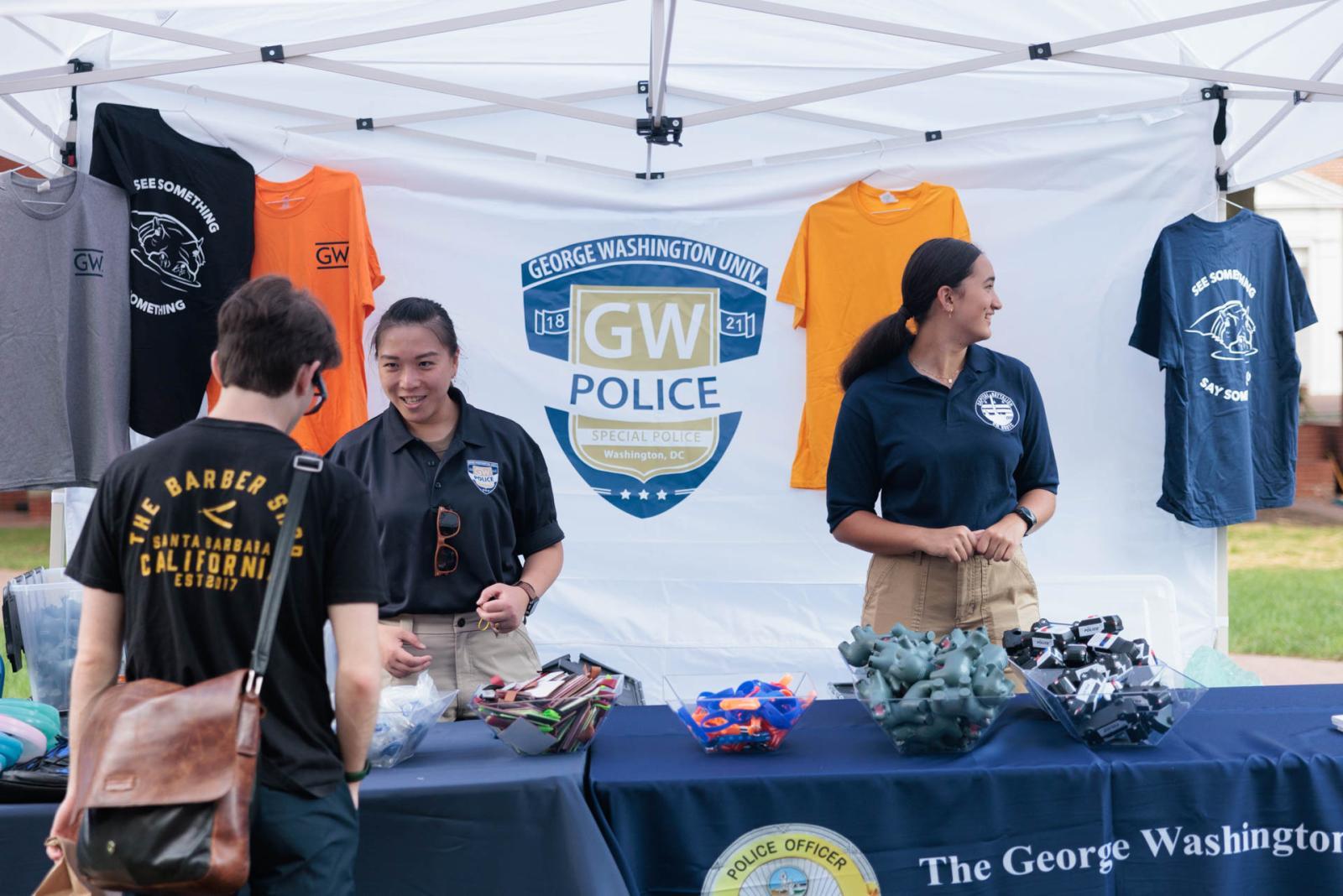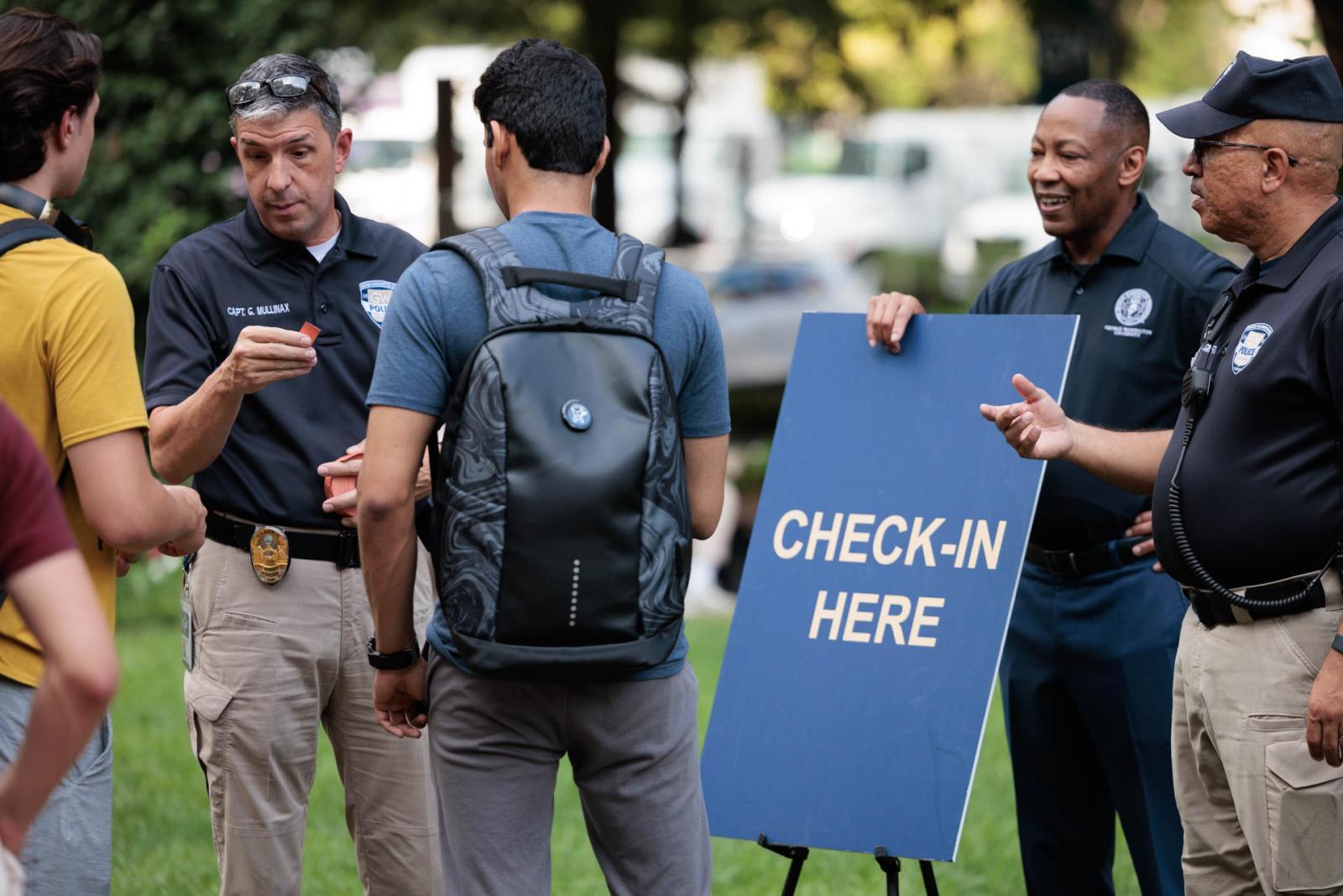George Washington University hosted two conversations with staff and students last week to answer questions about the initiative to arm specially trained GW Police Department (GWPD) supervisory officers.
The goal of the virtual events was to help GW community members gain more insight into the arming implementation process and ask questions. The university recently completed the first of a multi-phase process, arming executive supervisory officers Chief James D. Tate and Captain Gabe Mullinax.
Throughout both conversations, the university received questions regarding training, requirements and types of response for armed officers; oversight; and trust, accountability and engaging with GWPD. Community members also voiced agreement or disagreement with the arming decision itself and asked questions about the rationale. Recordings of the conversations are available on the GWPD website.
During the two conversations, Tate answered various pre-submitted and live questions that came from the more than 200 staff and students who registered for the sessions. Additional engagement opportunities for faculty will be planned in collaboration with faculty leadership.
Staff conversation
The discussion with staff was held Wednesday morning, featuring a Q & A session with Tate. Sabrina Minor, vice president of human resource management and development and chief people officer, moderated the session.
“I just want to take a moment to acknowledge the importance of community engagement,” Tate said at the outset. “That's something we've been working hard at the last few months, and it's something that, quite frankly, will continue not just through this semester but for the entire academic year and for years to come. These types of meetings are helpful to us as we continue with our implementation.”
GW Staff Council President Bridget Schwartz also provided brief remarks at the beginning of the discussion, noting the “incredibly important” conversation and that she looks forward to hearing from GW staff on the arming topic.
The first question asked of Tate was why GWPD felt the need to be armed now and in what past circumstances would the university have benefitted if officers had been armed.
Tate said because of rising gun violence both nationally and locally, officers need to be able to respond to life-threatening emergencies on campus quickly. He referenced an incident on the Foggy Bottom campus that occurred Sept. 6 when a dangerous individual escaped police custody at GW Hospital.
“I was on my way to the command post when a call came out about a possible sighting of this individual just outside of a building on our campus,” Tate said. “And so rather than responding to the command post, I immediately diverted and responded to the area in which this individual was reported to be. Had I not been armed, I would not have been able to respond in that way. I didn't hesitate because I knew that had I come across this individual, I would have had the capability to confront him, contain him and hopefully arrest him without incident.”
Tate explained that GWPD officers are better suited to respond to incidents on campus because of their proximity and detailed knowledge of the buildings on campus.
“We're here 24/7, and it is familiar territory,” Tate said. “We know the campus geography and the facilities on our campus. Our officers are closer to the call and when the danger is happening in real time, not just minutes matter but seconds matter.”
The university announced in April that it would begin planning to arm GWPD supervisors and would solicit feedback from the university community on implementation. In late August, GW announced a five-part multi-phase implementation plan with additional details and will continue to solicit feedback through all phases of implementation.
At the staff session, Tate answered a question that sought details about the training that GWPD supervisors would have before being armed.
He said supervisory officers will be required to undergo implicit bias training every semester, de-escalation training once a month, and mental health training and firearms qualification training three times a year.
GWPD supervisors will also go through simulation training that mimics real-life scenarios to improve on de-escalation tactics.
“When an officer goes through that training, a scenario will play out and the trainer can choose where that scenario will end up,” Tate said. “Most of those scenarios only require de-escalation, they don’t require the use of force. I’ve gone through many of those scenarios, they’re very realistic. I can tell you; your heart rate goes up, your blood pressure goes up. So, you get to see how officers will perform in those spaces.”
Tate said they’ve found officers who undergo the training improved their de-escalation skills exponentially.
Another question was about transparency and what GWPD will do to share information with the community when force is used.
“When the weapon leaves the holster, even if it's not pointed at anyone, that's considered use of force with a firearm, and it falls under the purview of the Independent Review Committee who will look at all use of force incidents involving a firearm regardless of if there is a complaint,” Tate said. “So, it doesn't take someone raising their hand to say they have an issue with it. They're going to look at it anyway. And that's the way it should be, in my opinion.”
Tate noted that GWPD keeps demographic data that indicates the race, gender and ethnicity of individuals being stopped by officers. The information also details aspects of the encounters including whether force was used. A Use of Force Policy also is posted online and includes updates based on feedback from the university community. Additionally, GWPD officers use body-worn cameras to support transparency, and Tate makes it a priority to review footage randomly in addition to when there are concerns.
“All of that information is out there, and I think that’s part of being transparent as well,” Tate said. “We want to make sure we're continuing to listen and get feedback from our community, from all corners of our community.”
Student conversation
On Friday afternoon, Tate fielded questions from students on arming implementation and potential impact on campus safety during a virtual conversation moderated by Vice Provost for Student Affairs and Dean of Students Colette Coleman.
In opening remarks, GW Student Association President Arielle Geismar said that she was against arming GWPD officers.
Geismar also outlined plans for creating a GWPD accountability task force within the Student Association and highlighted the desire to include student voices during all phases of the decision-making process.
Tate acknowledged the importance of community engagement and pointed to a “very wide net” of opportunities for sharing feedback on implementation—from public meetings to the GWPD website. “We’re listening closely,” he said. He also added that GWPD planned to form a Campus Safety Advisory Committee made up of students, faculty, staff and community leaders who “represent the broad life experiences and diversity of our community.”
As in the staff conversation, many of the students’ questions involved officer training requirements, which Tate called “robust and comprehensive.” In addition to the monthly training sessions and a virtual reality simulator that Tate mentioned in the staff event, he said that supervisory officers undergo psychological evaluations and background checks before arming.
One student submission questioned how GWPD would address the concerns of students from BIPOC—Black, Indigenous, (and) People of Color—communities who are disproportionately impacted by police violence. Tate noted that the issue has been “top of mind for me” throughout his career at GW and that his office continues to seek input from campus groups like the Black Student Union, including by participating in a public safety forum the BSU hosted Tuesday. He also stressed the importance of the GWPD implicit bias and de-escalation training strategies.
“All of our officers understand that we are part of the same campus community, and we have a responsibility to treat members of our community with respect, dignity and care,” he said.
Later, he responded to a question about limiting police interactions with people with disabilities and mental illness by noting that officers typically defer to emergency medical personnel in cases that may involve a mental health crisis.
“We want to give people the resources they need and certainly not make things worse by showing up with…a large police officer footprint when you really don’t need it,” he said.
Next steps
Tate said GWPD would continue incorporating community input as the implementation process continues. He invited all community members to share feedback through the GWPD website and to attend future events, including some that will feature the supervisory officers themselves.
Tate also plans to continue to attend smaller in-person meetings and events around campus with various groups and stakeholders. In addition to arming implementation, the university also is addressing broader safety enhancements, such as mental health support, building security, active shooter response training, and emergency notifications.
“And, of course, if you see me on campus and you have a question, just say, ‘Hey, Chief, here’s a concern,’” Tate said. “I want to be available. I want to be accessible.”
As engagement continues, the university continues its work toward the next phase of implementation, which is expected by the end of September. This phase involves arming four lieutenants once they complete the requirements outlined in the implementation plan.
This expands the university’s ability to respond to emergencies while allowing time for additional community engagement. Planning for more engagement opportunities through this part of the process is underway.







